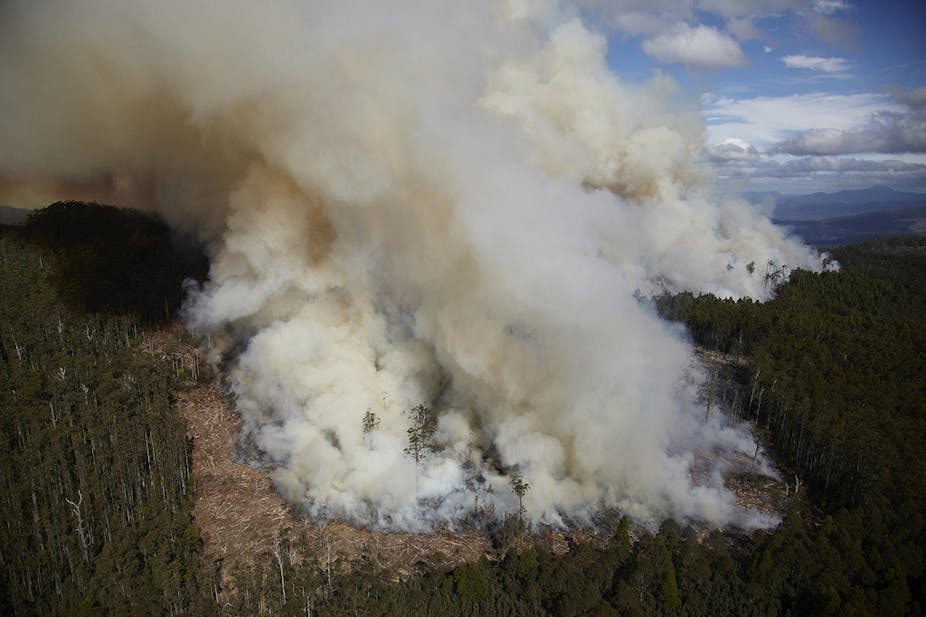The Tasmanian forestry industry is already thinking beyond the federal and state governments’ plans to abolish the Tasmanian Forestry Agreement, which include trying to remove 74,000 hectares of forest that currently falls under World Heritage listing and protection.
Later today (Australian time), the World Heritage Committee is expected to publish its draft recommendation about whether it would take the unusual step of delisting part of the Tasmanian Wilderness as a World Heritage Area. That draft decision is likely to shape the final decision made next month at a meeting in Doha, so will be closely watched by foresters and environmentalists alike.
(You can view a map here of the areas the Australian government has proposed removing here, or an interactive ABC version here.)
But even before the World Heritage Committee makes its call, many in Tasmania are already looking ahead.
Rather than returning to old, clear-fell harvesting methods, the industry is looking forward to new strategies that could benefit biodiversity, industry and our response to climate change.
Is the age of clear-felling, burn and sow ending?
Forestry Tasmania is currently managing some 742,000 hectares of forest, for which it is seeking Forest Stewardship Council (FSC) certification. These forests are outside the World Heritage wilderness area.
In a draft plan for production forests managed by Forestry Tasmania deemed “High Conservation Value”, it proposes to use different harvesting methods, rather than clear-felling trees. The plan is currently open to comment.
The draft report states that there are 10 areas covering a total of 12,800 hectares with high conservation value in the Forestry Tasmanian management zone that should be logged using alternatives to clear-felling.

Specialty timber industries representatives, such as respected Tasmanian boat-builder John Young, are also calling for an end to clear-felling if forests in the World Heritage area are made available to logging.
Clear-felling is the first part of a three-step harvesting method, followed by burning and then sowing. Young is concerned that the method is unnecessarily destructive of renowned Tasmanian specialty timbers such as celery-top pine, which occur in temperate rainforest and in the understoreys of old-growth eucalypt forests.
High intensity fire is the real problem
High intensity fires used to create the perfect conditions for eucalypt seedlings to thrive come with costs to biodiversity, specialty timbers and carbon storage.
There’s no question that this regeneration burning results in thriving regrowth. But it is surprising that we still don’t fully understand why this is the case.
Boiled down to basics, research shows that high intensity burning does two things. First, it provides a pulse of nutrients, particularly phosphorus, that encourages rapid growth of eucalypt regeneration. Second, fire is a form of “clearing”, removing both plants and soil organisms that can hold back eucalypt seedlings through above-and-below ground competition.
In a nutshell, high severity fires are a “cheap” and efficient herbicide, fungicide, and fertiliser. Burning also reduces the fire hazard posed by logging debris in the years immediately following logging, although some ecologists assert that large tracts of regenerating forest in a landscape increase fire risk.
But burning also destroys fire-sensitive trees that the specialty timber industry relies on, reduces air quality (and hence human health), and releases huge amounts of greenhouse gases. Rethinking high intensity burning is long overdue.
Burning the carbon budget
Clear-felling and burning of mature eucalypt forests releases about 200 tonnes of carbon per hectare, or around 60% of the post-logging above ground biomass due to the combustion of coarse materials (branches of more than 7 cm diameter). Subsequent regrowth that would remove carbon from the atmosphere and store it in timber is unlikely to reabsorb all the released carbon because the planned forest rotations are too short to allow trees to return to the large, old-growth stage.
From a strictly emissions-based perspective, it would be best to leave the coarse debris unburnt. A second best alternative would be removing logging debris and burning it in furnaces to produce electricity, as this would at least offset the use of polluting fossil fuels to make electricity.
But removing logging debris wholesale would diminish soil fertility and would have an adverse impact on the biodiversity that depends on logs and other forest debris.
Given the climate cost of carbon emissions, clear-felling and burning cannot be considered “cheap”, and is inconsistent with Australia’s ambitions to reduce greenhouse gas emissions.
Next steps
Currently there are Australian schemes that reward initiatives to reduce greenhouse gas emissions in forestry and land management, such as the Carbon Farming Initiative. This includes reducing the intensity of fires in tropical savannas, and restoring forest cover to landscapes that have been cleared.
The federal government’s Direct Action policy is likely to be based on similar principles, and could theoretically reward moves away from clear-felling and burning in Tasmania.
The research challenge now is to find alternative ways to create the conditions needed to regenerate logged eucalypt forests. This may involve mechanical disturbance to create a seedbed, lower intensity fires to reduce fire hazard from fine fuels, fertiliser to stimulate rapid growth, inoculating seedlings with beneficial fungi, and controlling soil pathogens.
These alternatives can open up new and more productive ways of logging eucalypt forests, which will be more socially acceptable and ecologically sustainable.
If we don’t need high intensity burning, smaller areas can logged, and dispersed across landscapes. This would reduce the visual impact of logging, and increase carbon storage, habitat diversity and biodiversity values.
Supported by adequate research, the old-fashioned clear-fell and burn approach could be supplanted by selective, low-impact logging, and a renaissance of the Tasmanian forestry industry.

